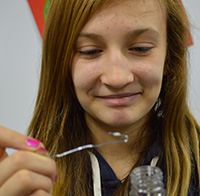Inside a 40-footmobile classroom parked outside their school, Southwood Elementary students got to the “true core” of their food — its basic building blocks — by extracting DNA from wheat germ. The activity followed a multi-step process and ended with little bits of goo on paper clips fashioned into hooks.
Resulting in “oohs,” “ahhs” and looks of both fascination and disgust, they had successfully separated DNA using a mix of water, alcohol and detergent.

During the lesson taught by Lindsay Grasman, a science lab educator at Food, Agriculture & Resources in Motion (FARM), fifth-graders learned about agriculture, and how genetics play a role in all living things including the crops raised by Michigan farmers.
Kentwood Public Schools is piloting the FARM program through the Michigan Farm Bureau’s Agriculture in the Classroom program. It is the brainchild of a group of farmers working with 26 Michigan county farm bureaus. The pilot program continues through June with 26 schools in Kent and Oakland counties.
The purpose, Grasman said, is to help teach students about how food gets to the table and the role of agriculture in their lives. The mobile lab is equipped with tablets, where students work in lab spaces, and other technologies for presenting lessons tied to Next Generation Science Standards, a set of teaching guidelines for kindergarten through 12th-graders.
In Michigan, agriculture is the second largest industry in contributing more than $101 billion to the state’s economy, according to the Michigan Agriculture in the Classroom website. Michigan produces more than 300 commodities, making it the state with the second most diverse agriculture industry in the nation, behind California.

Every Living Thing
“It helps them learn more about where their food and fiber comes from,” Grasman said. “We want them to have a more informed consumer base.”
The genetics lesson had students’ interest piqued.
“I thought it was very cool to learn that DNA is actually in every living thing, even wheat,” said Kyle Olsen.
Added Breanna Duron: “I didn’t know wheat had DNA. I thought only animals did. I like how they didn’t just show us in a movie. They had us do it ourselves and see it with our own eyes.”

The lab offers several other activities, including making plastic out of corn starch, measuring contaminants in water, making soy-based crayons, and food safety.
Nancy McKenzie, the district’s STEM coordinator, requested Kentwood be included in the pilot program. Seven district elementary schools participated. “I’m sure most of them don’t know where food comes from before the grocery store,” she said. “This gives them a little insight into that, one little part and parcel of the agricultural business, but it also fits with all our science standards.”
“I love to see the excitement they get when they go through the whole process and get to the end product. It’s fun to see them excited about working in a lab setting.”

The Michigan lab was modeled after the Mobile Science Activity Center from Kentucky’s Department of Agriculture, which visited North Godwin Elementary, in Godwin Heights Public Schools in 2015 at the request of Michigan Farm Bureau.
CONNECT
Michigan Agriculture in the Classroom










